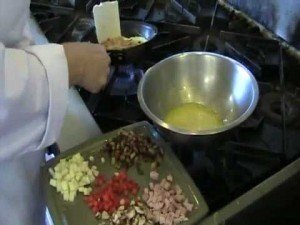Exquisitely simple, yet enormously complex, the egg is one of nature’s marvels. The real facts about eggs have been scrambled in recent years, as they’ve gotten a bad rap for being high in cholesterol and fat. This singular view has ignored the enormous benefit of fresh eggs to the human body and the entire culinary world.
Nature designed the egg as the food source for developing chicks. Eggs, in particular chicken eggs, are also an excellent food for humans because of their high protein content, low cost and ready availability.
I recently put two types of farmer’s market eggs to the test in “The Farm Eggs Challenge: Cage or No Cage?”,examining the type of feed and environment and its impact on the final product. Both farmers I interviewed were passionate about treating their birds humanely and producing a high quality product. But there were differences between the two philosophies.
The most nutritious eggs ARE the freshest, from your local farm. Nutrition declines with age in an egg that must be shipped across the state or the country. Often, eggs must be additionally treated for such a long journey, even if that means exposing them to unnatural treatment until purchased by you.
You can see the differences between a “national” egg and the two farmers market eggs in the “Egg-lympics” I created in “The Great Egg Test Cracks The Case!”
One of the stunning facts about eggs comes from the Food and Agriculture Organization of the United Nations, which has created a scale to measure the efficiency with which protein is used for growth in the human body. This is called a “Biological Value”.
Egg contains the highest quality food protein known. Based on essential amino acids it provides, egg protein is second only to mother’s milk for human nutrition. On a scale with 100 representing the top efficiency, eggs are rated at 93.7 percent in protein efficiency.
One of the many beneficial elements in an egg is called Biotin, one of the B vitamins which play an important role in cell metabolism and the utilization of fats, proteins and carbohydrates in the human body. Biotin is present in egg yolk. An egg white omelet may have less fat, certainly has no flavor, but also omits this important B vitamin.
While eggs are widely known as breakfast entrees, they also perform in many other ways for the knowledgeable cook. Their cooking properties are so varied, that they have been called “the cement that holds the castle of cuisine together”.
When you know the true facts about eggs, you’ll realize that there is barely an area of the kitchen, for the professional or the home cook that eggs don’t touch.
Eggs can:
Bind – meatloaves, Lasagna, croquettes
Leaven – baked goods, soufflés, and sponge cakes
Thicken – as in custards and sauces
Emulsify – mayonnaise, salad dressings, hollandaise sauce
Coat or Glaze – cookies or breads
Clarify soups – to make consommé
Inhibit crystallization – in boiled candies and frostings
Garnish – chopped egg whites and/or yolks give a finishing touch.
Eggs are composed of three basic parts, the shell, the yolk and albumen. The shell is made of calcium carbonate, and prevents microbes from entering as well as moisture from escaping. It’s the casing that protects the egg during handling and transport. The color of the egg shell is determined by the breed of the hen and has no bearing on its nutritional value or flavor.
The egg yolk is the yellow portion of the egg which takes up only 1/3 of the egg’s mass, but accounts for ¾ of all the calories, minerals, vitamins, and all of the fat. The yolk contains lecithin, which is an emulsifier that enables us to make mayonnaise, dressings, and hollandaise sauce.
Albumen is the clear portion of the egg, often referred to as the egg white, taking up 2/3 of the eggs mass but none of the fat and only 16 calories. Whipped egg whites can hold twice their volume in air, and create a protein web that helps leaven baked products. There’d be no Angel Food Cake without whipped egg whites, among many other baked goods.
What about that pesky strand that always seems to cling to the shell when you’re trying to crack them? This is called the “Chalazae Chord”. It’s the thick, twisted strands of egg white that anchor the yolk in place, They are NOT embryos nor imperfections as many people believe, but the more prominent the chalazae, the fresher the egg.
Don’t be chicken! Seek out the true information concerning all the food you eat. Eggs have been the victim of bad press in recent years. This is nature’s perfect food; it helps build cells, helps us metabolize nutrition, and has given us almost every sweet and savory pastry you’ll find in the bakery. The facts about eggs say they deserve another chance, and they deserve our respect.
Discover the difference between how professionals and home cooks are taught in my next
FREE Webinar Workshop
Claim your FREE Spot for the next webinar session by CLICKING HERE



As always, full of interesting info. Your webcasts have help me tremendously in the kitchen.
Thanks for the kind words, Nereida. The kitchen is perhaps the most fun room in the house! lol